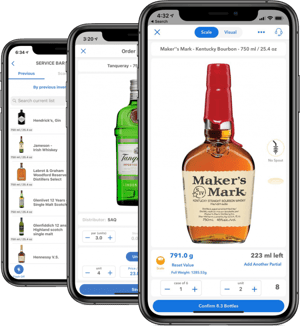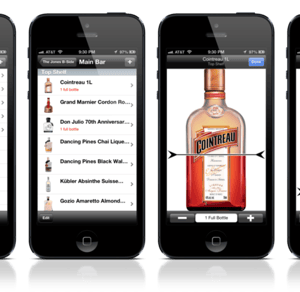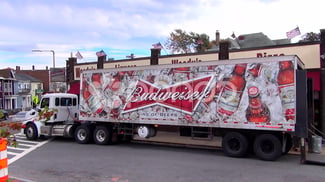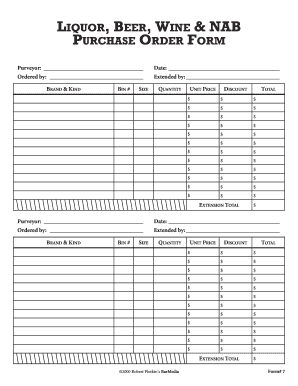If you’re considering upgrading your liquor inventory system, it’s important to first think about the goals you would like to achieve out of the inventory process. This will help you narrow down your options to focus on the solutions that address your specific goals.
There are a wide range of sophisticated bar inventory systems available. Each option takes a slightly different approach to the process, and you’ll want to find one that will work effectively in the context of your bar’s business model. That being said, there are certain elements that a good inventory system must possess in order to help you achieve your goals.
Identifying the Goals for Your Bar Inventory Efforts
There are three different levels of bar inventory, and the specific level you need to strive for will depend on what you’re trying to achieve with your inventory efforts:
 Level 1 inventory – Seeing what’s on the shelves so you can do your ordering
Level 1 inventory – Seeing what’s on the shelves so you can do your ordering- Level 2 inventory – Calculating your liquor cost by category
- Level 3 inventory – Drilling down into individual performance of products by comparing how many servings were poured vs. sold
Level 1 inventory is the most basic function for this process. You need to make sure you always have enough product on-hand, and counting your inventory will ensure you always know what you need to order. There is no analytics data generated with level 1 inventory. You’re simply making sure you have enough product on-hand.
Level 2 inventory helps you achieve some basic analytics data that will give you a broad understanding of your liquor cost. While this data can allow you to evaluate trends over time, it won’t really provide you with the detailed information necessary to make significant improvements to your bar’s operations.
Level 3 inventory provides the most effective use of your liquor inventory efforts. By precisely comparing what was poured vs. sold for every product you carry, you can identify specific products that are underperforming (either due to overpouring or being given away). This will allow you to make changes to your day-to-day operations that will ensure your staff is selling a higher percentage of everything being poured.
By providing level 3 inventory services, we’re able to help our clients reduce their liquor cost by 3% on average. Over time, this equates to a significant increase in profitability.
Deciding between Level 2 and Level 3 Inventory
If you’re looking to get anything beyond knowing what you need to order out of your liquor inventory efforts, you’re choosing between a system that will provide level 2 vs. level 3 results. You need to make a distinction regarding whether your goal is to do level 2 inventory and simply calculate liquor cost, or whether you want to use this opportunity to take your bar inventory efforts a step further by using them as a tool to increase profits. When choosing a new liquor inventory system, this is an important decision that will dictate which options you should be evaluating.
 Many bars looking to achieve level 2 inventory choose one of the app-based systems on the market. These options provide automation and time savings benefits, while also allowing you to achieve certain basic data such as calculating your liquor cost by category.
Many bars looking to achieve level 2 inventory choose one of the app-based systems on the market. These options provide automation and time savings benefits, while also allowing you to achieve certain basic data such as calculating your liquor cost by category.
Level 3 inventory is a more complicated task and has more elements involved in the process. If you’re looking to achieve level 3 inventory, you’ll need to find a system that also provides high levels of precision and robust analytics data.
We’re going to discuss the essential elements that need to be considered for a system providing level 2 inventory. In our next post, we’ll dive into the elements to consider for systems providing level 3 inventory. When you’re evaluating bar inventory systems to use at your bar, think about how each option addresses these elements. This will help you determine the best solution for your bar’s unique needs.
What Are the Most Important Elements Necessary for Level 2 Inventory?
Level 2 inventory isn’t as advanced as Level 3 inventory and as a result, most of the elements you need to evaluate involve the way the system works (as opposed to the data it provides).
Setup
Any inventory system you use is going to require that you enter the items your bar carries into the system. Many systems that don’t use barcode scanners are going to require that you type the name of the product into the system. This is an inefficient way to address setting up your system, and it will provide a poor user experience:
- Often, the dropdown menus used by these systems will require you to search through more than 20 different options to find the specific product you want to add.
- This is time-consuming, and the chances of you selecting the wrong size or flavor of a particular product is significant.
Systems that use barcode scanners provide a much simpler process:
- Pick up the bottle
- Scan the barcode
- The correct product is automatically entered into the system
Bar-i’s counting system comes preloaded with the barcodes for over 25,000 items. This provides a fast, accurate and efficient way to set up your system.
Counting
An important part of the inventory process is counting the bottles behind the bar and in your storeroom. It’s important to think about the counting system used by the different inventory options you’re considering.
 Some of the app-based systems count using a tenthing process powered by software. This doesn’t provide an accurate or objective measurement since your counter is estimating the percentage of liquor that is left in the bottle. As a result, you lose a lot of detail. This is fine if you’re only looking to achieve level 2 inventory, but it prevents you from being able to achieve level 3 inventory down the road if you were to decide you want the analytics data necessary to improve your bar’s profitability.
Some of the app-based systems count using a tenthing process powered by software. This doesn’t provide an accurate or objective measurement since your counter is estimating the percentage of liquor that is left in the bottle. As a result, you lose a lot of detail. This is fine if you’re only looking to achieve level 2 inventory, but it prevents you from being able to achieve level 3 inventory down the road if you were to decide you want the analytics data necessary to improve your bar’s profitability.
In order to experience the benefits of level 3 inventory, you’ll need data that is accurate to a much higher level of detail (down to the serving level, which is typically 1.5 oz. for cocktails). This requires the use of a precise measuring device. We feel that scales provide the best method of measuring your products to the level of detail necessary to generate accurate analytics data while also providing a fast and easy user experience.
Pricing
In order to calculate your liquor cost, you need to first determine the value of alcohol being poured during the inventory period. The easiest way to do that is to measure how much alcohol (in dollars) you had at the start of the period, how much (in dollars) you had at the end of the period and take the difference. Figuring out this value involves multiplying the number of bottles you have by the price of a bottle.
You need to have a way to get the price of these bottles entered into your inventory system. Normally this will come from your purchase invoices. With Bar-i’s pro version, you scan these invoices into the system and we update all the prices every time you count your inventory.
Delivery Values
 When calculating liquor cost, you also need to know how much inventory in dollars you have at the start and end of the period. This is impacted by the value of the deliveries you receive. These deliveries must be accounted for in order to get an accurate assessment.
When calculating liquor cost, you also need to know how much inventory in dollars you have at the start and end of the period. This is impacted by the value of the deliveries you receive. These deliveries must be accounted for in order to get an accurate assessment.
Therefore, you need to have a method for figuring out how many dollars you spent purchasing your products. You need to be able to break up the different items on the invoice to figure out exactly how much of the total dollar value of the purchase was draft beer, bottled beer, liquor and wine.
This task is often handled by accounting platforms such as QuickBooks, but it’s important that you’re able to determine how much was purchased for each of these product categories during the inventory period. When evaluating inventory systems, you’ll need to think about the process used to get those purchase amounts into the system.
Sales by Category
Once you’ve worked out the value of the amount of product poured for each category during the period, you need to divide this figure by the total dollar value of sales. All modern POS systems will split your sales into these categories for you, making it an easy process to determine your total sales by category (draft beer, bottled beer, liquor and wine). Bar-i integrates with over 40 POS systems, allowing you to automate this process.
Ordering
 Most inventory software will allow you to enter pars for every product, making it easy for your inventory system to tell you what needs to be ordered each period. This process provides time-saving benefits since your orders are automatically generated for you. More importantly, it can help you significantly reduce the amount of inventory you have on-hand.
Most inventory software will allow you to enter pars for every product, making it easy for your inventory system to tell you what needs to be ordered each period. This process provides time-saving benefits since your orders are automatically generated for you. More importantly, it can help you significantly reduce the amount of inventory you have on-hand.
Analytics
Level 2 inventory systems only offer basic analytics data. Mainly, you’re getting your liquor cost broken down by category. This is useful to help you spot trends, such as whether your liquor cost is rising or falling over time.
You may also be able to get a few advanced metrics with level 2 inventory systems. Some of these options will allow you to look up how much inventory you have on-hand as a percentage of what you use each week. From our experience, we’ve found that well-run bars keep less than four times the amount of inventory they use each week on-hand. You should look for a system that provides these types of advanced metrics since it will enable you to run your bar more efficiently.
If you’d like to learn more about how Bar-i can help you streamline your operations and boost profits, please contact us today to schedule a free consultation. We serve bars and restaurants nationwide from our offices in Denver, Colorado.


-1.png)